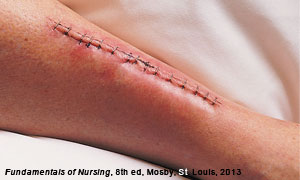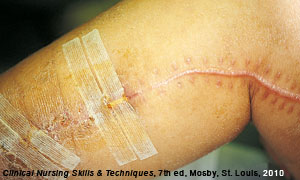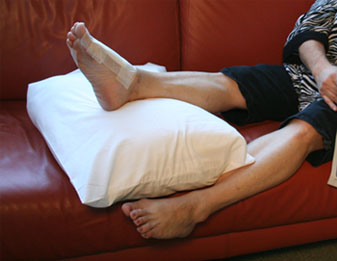What to Do
There are many ways that you can help a person after their surgery. Always be a good observer and provide support for any orders the surgeon has prescribed. Keep notes in your care diary to describe how the person progresses.
Look at the Wound and Dressing
A surgeon closes a wound with stitches, staples or sometimes with glue. In many cases a wound will not be covered with a dressing. It may only be covered with a band-aid.
Look at the wound when the person first comes home, then at least once a day or whenever the person tells you their wound bothers them.
If the wound is covered with a dressing (such as gauze or a clear transparent dressing), the surgeon may or may not have you change it. If you do change it, then look at the wound and dressing during each change. See our lessons on Changing a Gauze Dressing and our future lesson on Transparent Dressings
If a dressing is covering a wound, it is important for it to remain clean, dry and intact. Do not let the dressing get wet. Talk to the person’s doctor or home health nurse on ways to keep a dressing dry.
Tips on What to look for: The surgeon will tell you what to expect and give you a list of the type of problems to report. Follow these directions exactly. Here are some tips on what to look for:
- Does the wound look different since you last looked at it? Has the size changed or does it look deeper?
- Are the wound edges closed together?
- Are the wound edges reddened or swollen? (Some pink to light redness and swelling along the wound is normal.)
- Is there any drainage? If so what is the color; bloody, clear, yellowish, or greenish? If a dressing is in place and there is drainage, you will notice a change in the color of the gauze.
- Notice the size of the area discolored on the gauze, this gives you an idea of the amount of drainage. Also – when you change a gauze dressing, count the number of gauzes that contain drainage.
- Does the person tell you there is pain or discomfort around the incision?
- If the wound has stitches or staples – are they all in place?
When you think there is a problem with a person’s wound – call their surgeon immediately.
A Normal Wound – A normal wound has these features:

First 24 hours
- Edges of the skin are closed, either by staples, stitches or glue.
- Any drainage is clear or light pink
- Skin along edges of the wound will be reddened, swollen, and be warm or throbbing from normal inflammation.
- Skin is tender to touch.

Next 2 to 3 days
- Edges of the skin are closed, either by staples, stitches or glue.
- Drainage becomes more clear.
- Inflammation with redness, swelling, warmth and throbbing still present.

3 to 24 days
- Drainage stops
- Wound fills, closing any space between skin edges.
- Size of the wound begins to shrink.
- Redness and swelling of skin disappear.
At times, when a wound heals, the person may feel the need to scratch the area, as it may itch. Discourage this activity as this can cause skin abrasions and infection. Also be sure that the tape holding the dressing is not causing a skin reaction. When you change a dressing, look at the skin. When the person is sensitive to tape, there will be redness, and sometimes even blisters. If this is noticed, call the doctor or the person’s Home Health nurse.
Wound Infection – If an infection forms in a wound, look for these signs:
- The person complains of pain at the site.
- When you lightly press your hand or fingertips over the skin next to a wound, it will be tender to the person.
- The skin around the wound will be more reddened and swollen than normal.
- The skin around the wound will feel warm to the touch.
- The wound will have yellowish or greenish drainage.
- The person might have a fever (100.5 degrees Fahrenheit [oral] or greater, or 101.5 degrees [rectal or ear temperature] or greater).
Bleeding - Ask the doctor or the nurse at the hospital how much bleeding should occur after the surgery and when to call and report bleeding. Within 2-3 days after surgery any bleeding should have stopped. Call the doctor if bleeding is still occurring after this time.
Write down what you observe about the wound and dressing in your care diary. If you suspect an infection call the surgeon immediately.
Care of Drains and Drainage Tubes
Sometimes a person will come home with a drain or drainage tube placed inside the wound. The purpose is to help drain fluid that builds up inside the wound. A wound always heals from the inside out. Removal of any extra fluid helps a wound heal more quickly.
- Drains are usually removed at a follow up doctor’s visit or by a home health nurse.
- Always know whether the drainage tube is supposed to be flat, or compressed and know the steps of what to do, and how to care for these external drainage tubes.
See our Lesson on Care of Drains and Drainage Bags
Activity
A person’s activity may or may not be limited after surgery. The surgeon will provide specific guidelines for the person to follow.
- Most people receive guidelines for a progressive return to full exercise. This means the person may start out walking a certain distance, and then increase the time walking or distance to walk each day, until he or she returns to normal. Remind the person to get up to walk and help them keep track of their progress in your care diary.
- Always urge a person to stay as active as possible, within their limits. This means, letting them dress and feed themselves, do their own shower or bath, within limits set by the doctor.
- Lifting objects is often limited. Lifting can place strain on stitches. The surgeon will tell the person the amount of weight restricted. For example, a person who has had bladder surgery may not be able to lift anything over 10 to 15 pounds for several weeks. If the person you care for has lift restrictions think about what they do each day to decide what is safe for them to do.
- Do they carry laundry down stairs? If so, how much does that weigh?
- Do they normally pick up a pet or an infant or baby? What do they weigh?
- Do they normally pick up large objects when they do grocery shopping?
Activity Restrictions - Sometimes a person will have specific activity restrictions, depending on the type of surgery. Here are a few examples:
- Walking up and Down Stairs – There are many cases where a patient is not allowed to walk up or down stairs for several weeks. The muscle movement and effort to go up or down stairs is often limited when surgery involves the legs.
- Driving a Car - Driving is possible when it is safe for a person to sit up in a car, bend their knees, apply pressure to brakes, and have enough muscle control to properly operate the brakes and accelerator. Driving restrictions may be in place for several weeks until it is fully safe for a person to drive.
- Hip Precautions – After a total hip replacement, a person must avoid excessive flexion, adduction and internal rotation of the hip. This means he or she should not sit straight up in bed or bring the leg with the new hip up toward their chest.
Place a pillow between their legs to maintain their proper position and to keep their legs apart. Do not let the person rotate their leg with the new hip inward. These precautions prevent dislocation of the new hip.
Physical Therapy - Many patients have physical therapy after surgery. A physical therapist decides on the types of exercises a person needs to do in the home to be sure of a safe and full recovery.
- The person will see the therapist in the hospital before being sent home. In the case of outpatient surgery, the person will need to follow up with an appointment in an outpatient physical therapy setting. Be sure the person follows their exercise plan at home.
Do Not Place Stress on a Wound
Any physical stress, especially on a surgical wound, can cause the edges of the skin to separate. This is very important during the first 24 to 72 hours after surgery. Protect a person’s wound by following these tips:

- Have the person place a pillow over their wound, and hold it firmly with their hand over the wound to splint it when coughing. If the person cannot splint a wound themselves, you can position a pillow or take your hands and place them flat over the wound, and apply light pressure to splint as the person coughs.
- Vomiting places stress on a wound. Have the person take any prescribed anti-emetic medicines or follow our tips in the future lesson Nausea and Vomiting.
- Movement places stress on a wound. Have the person move slowly and not try to exercise past the level ordered by their doctor. After surgery a person may not be able to climb stairs or drive a car for several weeks.
Pain Relief
A person who has had surgery must know the type of pain to expect after surgery. The surgeon or nurse will explain the type of pain and how long it normally lasts.
- Be sure the person takes any prescribed pain medicine. This medicine will not cause the person to become addicted or dependent on the medicine as long as it is taken correctly.
- If you are helping to give a person their pain medicine, do not give extra doses.
- Do not wait longer than needed to give a dose. At first the person will have better pain control if the medicine is given regularly or an hour or so before daily activities need to be done.
- Call the doctor if the person continues to have severe pain, even after medicine has been taken.
- The person should not drink alcohol or drive when taking an opioid (narcotic) pain medicine.
Tips for Pain Relief
- When surgery involves the arm or leg, keep it raised up on pillows. This helps relieve the swelling that causes pain.
- If the person has an incision in their chest or abdomen (belly), have them hold a pillow firmly over the area when they cough, deep breathe or move about in bed. Splinting with a pillow supports the incision and prevents pulling and pain as the person coughs, breathes or turns.
- The doctor may order the use of warm or cold compresses over an incision. The proper use of heat or cold can promote healing. See our lessons on Cold Applications and Applying Heat.
- Help the person change positions in bed frequently. This takes the pressure off the incision, promotes circulation and normal breathing. See our future lesson on Positioning.
- Relaxation exercises along with use of pain medicine can help a person to relax more fully and gain greater pain relief. See our future lesson on Relaxation Exercises.
- Always be sure the person gets plenty of rest after surgery. Rest is needed to help the body repair itself.

Wound Care
Good wound care requires good handwashing. Washing your hands thoroughly before you change a dressing, is one of the most important steps to prevent infection.
- Always wash your hands at least 15 seconds before caring for a person’s wound. See our lesson on Infection Control for the video on how to wash your hands.
Follow the surgeon’s guidelines for changing a dressing. See our lessons on Gauze Dressings, Transparent Dressings and Caring for Stitches.
Circulation
A person’s circulation slows during surgery and afterwards as well, if the person is not active right after surgery. When the circulation slows and if the person has any problems with blood clotting, there is the risk of a person forming a deep vein thrombosis or DVT.
A DVT is a blood clot that forms on the inner wall of a vein, most commonly a deep vein in the leg. The risk of a DVT is that it can break off, enter the circulation, and then be carried up to the lung, with the potential of causing death. This risk is common in persons who have had orthopedic or vascular surgery.
- A person will often be told to wear a pair of elastic stockings after surgery. The stockings keep pressure on the outside veins of the leg to prevent pooling of blood. Instead of just staying in the veins, the blood moves up and into the veins back to the heart, so clots are less likely to form.
- Ask the doctor or the nurse at the hospital when the person should wear the stockings and when they can be left off. See our lesson on Elastic Stockings for proper fitting and application.
Diet
Each person will have orders for the type of diet and the amount of fluids to take after surgery. This will depend on their type of surgery, and whether they feel queasy from anesthesia when they go home. For example, if a person has surgery on the digestive tract, return to a normal diet will take a few days. A person who has an arthroscopic procedure of the knee will be able to eat a normal diet the next day.
The surgeon may order a progressive diet. This means the person may start with full liquids and soft food, and then gradually add solid foods. As a caregiver, you want to observe:
- How the person tolerates the diet: how much is eaten?
- How many glasses of liquids does he or she drink?
- Does the person get full easily or become sick to their stomach?
A return to a normal diet promotes:
- Wound healing
- Regular pattern of passing stool and urine
- Energy to do normal activities
Provide meals when a person is rested and pain is mild. If the person feels queasy or sick to their stomach, delay the meal or offer a small snack, such as a piece of toast, or liquid broth. Always offer 6 to 8, eight ounce glasses of fluid each day (unless the person has limits). For more information, see our lessons on Nausea and Vomiting, and Feeding a Person.